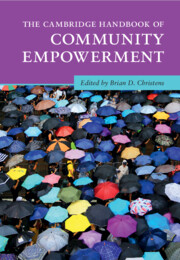Book contents
- The Cambridge Handbook of Community Empowerment
- Cambridge Handbooks in Psychology
- The Cambridge Handbook of Community Empowerment
- Copyright page
- Contents
- Figures
- Tables
- Contributors
- Building Community Power
- Part I Organizing and Activism
- 1 Youth Organizing
- 2 Youth Activism in Postapartheid South Africa
- 3 Domestic Violence and Community Organizing in India
- 4 Congregation-Based Community Organizing
- 5 Immigrant Organizing and Activism
- 6 Online Racial Justice Advocacy
- Part II Participatory Governance
- Part III Civil Society and Coalitions
- Part IV Enterprise
- Part V Participatory and Community Arts
- Part VI Education and Engaged Research
- Contributor Details
- Index
- References
6 - Online Racial Justice Advocacy
from Part I - Organizing and Activism
Published online by Cambridge University Press: 18 April 2024
- The Cambridge Handbook of Community Empowerment
- Cambridge Handbooks in Psychology
- The Cambridge Handbook of Community Empowerment
- Copyright page
- Contents
- Figures
- Tables
- Contributors
- Building Community Power
- Part I Organizing and Activism
- 1 Youth Organizing
- 2 Youth Activism in Postapartheid South Africa
- 3 Domestic Violence and Community Organizing in India
- 4 Congregation-Based Community Organizing
- 5 Immigrant Organizing and Activism
- 6 Online Racial Justice Advocacy
- Part II Participatory Governance
- Part III Civil Society and Coalitions
- Part IV Enterprise
- Part V Participatory and Community Arts
- Part VI Education and Engaged Research
- Contributor Details
- Index
- References
Summary
This chapter examines the past decade of organizing against the carceral state under the banner of “Black Lives Matter” (BLM). It draws on my collaborative research with Color Of Change and the movement for transformative justice alternatives to prison and policing for gendered violence. I look at recent BLM mobilizations through three lenses. One tracks BLM’s macro-level gains for community power at the situational, institutional, and systemic levels. Another documents the micro-level psychological empowerment processes of Black queer feminist approaches that center Black joy, political education, and care for Black women. Lastly, I look at the meso-level organizational settings that bridge individual psychological empowerment and capacity-building with macro-level outcomes like policy changes and culture shifts. Drawing on Han, McKenna, and Oyakawa’s concept of the “prism” (2021), I coin the term “Black prism” to describe organizations like Color Of Change that build political homes to amplify the power of Black constituents.
Keywords
- Type
- Chapter
- Information
- The Cambridge Handbook of Community Empowerment , pp. 162 - 190Publisher: Cambridge University PressPrint publication year: 2024

